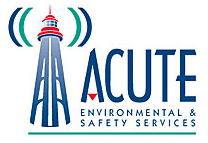Confined spaces training is essential for everyone whose job requires suiting up and climbing into these potentially hazardous areas. Contact the experienced professionals at ACUTE Environmental and Safety Service to get you trained and keep you safe on the job, and keep reading to find out three things you absolutely need to know before getting started.

What Are Confined Spaces?
According to the Ontario Ministry of Labour, Immigration, Training and Skills Development, confined spaces are fully or partially enclosed spaces that are not designed and constructed for continuous human occupancy and in which atmospheric hazards may occur because of their construction, location, contents, or because of the work that is done in them.
If your workplace has a space that is fully or partially enclosed, the two above conditions above must both apply before the space can be defined as confined.
Examples of confined spaces include tanks, vessels, silos, storage bins, hoppers, vaults, pits, manholes, tunnels, equipment housings, ductwork, and pipelines.
To determine whether a “space” meets the definition of a confined space, ask the following three questions:
- Is the space fully or partially enclosed?
- Is the space not both designed and constructed for continuous human occupancy?
- Might an atmospheric hazard occur?
“Atmospheric hazards” include the following:
- The accumulation of flammable, combustible, or explosive agents,
- An oxygen content in the atmosphere that is less than 19.5 percent or more than 23 percent by volume,
- The accumulation of atmospheric contaminants, including gases, vapours, fumes, dusts, or mists that could result in acute health effects that pose an immediate threat to life, or interfere with a person’s ability to escape unaided from a confined space.
The only way to determine if a specific area meets the definition of a confined space is to evaluate it, and how the evaluation is done is up to the employer.

Who Needs Confined Spaces Training?
Every worker who works in confined spaces must receive adequate training in the recognition of hazards associated with confined spaces, as well as training to be able to safely perform the assigned duties.

Training is also required for persons contributing to the work activity (i.e., performs related work) even those not entering the confined space, for example, attendants and rescue workers.
For example, ACUTE offers both a Confined Space Entry Awareness course, as well as Confined Space Rescue.
Note: Simply giving instructions to a confined space worker does not ensure that the worker is competent to safely perform work. Hands-on training should be an essential part of the confined space training.
In cases where a worker is new to the job and does not have sufficient experience, it’s good practice to make sure they’re teamed up with more experienced workers on top of receiving the necessary training.
What Is Involved In Confined Spaces Training?
Confined space training includes, but is not limited to, the following:
- Recognition and identification of potential hazards associated with the confined spaces that will be entered.
- Evaluation and control procedures for the identified or potential hazards.
- Familiarity with all equipment such as ventilation equipment (blowers), harnesses, and air quality monitors (e.g., Oxygen/combustible meters) that will be used while in the confined space.
- Familiarity with all personal protective equipment (e.g., respirators) that the worker will be using while in the confined space.
- Procedures for entering the confined space.
- Procedures to follow in the event of a situation developing that could present additional risk to the worker or an emergency.
- The specific work to be done while in the confined space.
The confined spaces training generally lasts eight hours and takes place in a single day.

Get Confined Spaces Training With ACUTE!
Acute Environmental – Confined Space from ACUTE Environmental on Vimeo.
Hands-on, practical confined space training is the best way to keep employers and workers safe in the workplace!
ACUTE is dedicated to workplace safety and understands the importance of course and training provider approval. ACUTE offers many training courses to help workers, employers, and everyone else involved stay safe on the job.
You can trust ACUTE to help your business understand your training challenges while also taking care of the most crucial aspect of a safety program: providing unparalleled tailoring and customer service. Here are just a few things you can expect when training with ACUTE:

- Open Door Instructor-Student Partnership – ACUTE’s training services emphasize client participation. Staff want to build relationships with clients and serve as a touchstone for advice anytime moving forward.
- Serving Your Team and Industry – With a vast array of clients in manufacturing, construction, health, academic, and government agencies, ACUTE brings the best safety practices from across the spectrum to your workplace.
- 100 Years Combined Experience – ACUTE provides comprehensive health and safety training, on-site safety services, and consulting services. With over 100 years of combined experience, our staff offer more than theoretical or abstract ideas. ACUTE offers solutions.
- Track Record of Success – ACUTE is rated 4.9/5 stars on Google reviews, demonstrating a commitment to our clients, quality, and passion for training.
“I was dreading the idea of having to spend 8 hours doing the mandated Working at Heights training. I began the training with the expectation that it would be dry and common sense. What I experienced was just the opposite. The training was extremely interesting and much more informative than I expected. Mike is a gifted presenter whose passion for this work and expertise in his field is obvious. If you need safety training of any kind, be sure to use ACUTE. We will most certainly be repeat clients for our business safety training needs.”
ACUTE is located in Waterloo, Ontario, and services customers from cities such as Toronto, Mississauga, Brampton, Hamilton, Milton, Kitchener, London, Guelph, and others across Ontario.
Source:
https://www.labour.gov.on.ca/english/hs/pubs/confined/cs_9.php


